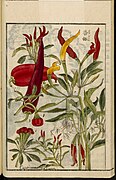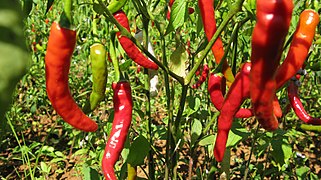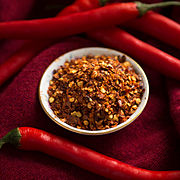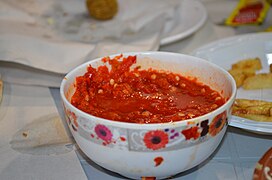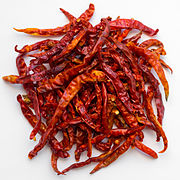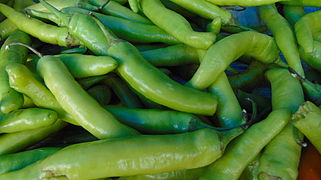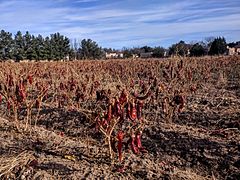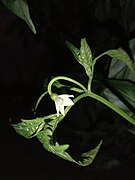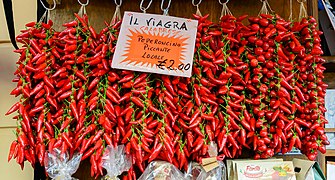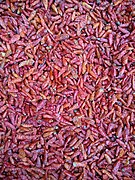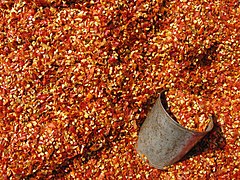Chili pepper
| Chili pepper | |
|---|---|

| |
| Scientific classification | |
| Kingdom: | Plantae |
| Clade: | Tracheophytes |
| Clade: | Angiosperms |
| Clade: | Eudicots |
| Clade: | Asterids |
| Order: | Solanales |
| Family: | Solanaceae |
| Tribe: | Capsiceae L. |
| Genus: | Capsicum L. |
| Varieties and Groups | |
| |
| Synonyms[2] | |
|
Synonymy
| |

Chili peppers, also spelled chile or chilli
Chili peppers are believed to have originated in Central or South America
Cultivars grown in North America and Europe are believed to derive from Capsicum annuum and have white, yellow, red, or purple to black fruits. In 2019, the world's production of raw green chili peppers amounted to 38 million tons, with China producing half.[10]
History
Origins
Capsicum plants originated in modern-day
Peru has the highest variety of cultivated Capsicum diversity because it is a center of diversification where varieties of all five domesticates were introduced, grown, and consumed in pre-Columbian times.[14] The largest diversity of wild Capsicum peppers is consumed in Bolivia. Bolivian consumers distinguish two basic forms: ulupicas, species with small round fruits including C. eximium, C. cardenasii, C. eshbaughii, and C. caballeroi landraces; and arivivis with small elongated fruits including C. baccatum var. baccatum and C. chacoense varieties.[14]
Distribution to Europe
When
Distribution to the rest of the world
The rapid introduction of chilis to Africa and Asia was likely through the
Production
This section is missing information about FAO data "Chillies and peppers, dry (Capsicum spp., Pimenta spp.), raw". (October 2023) |
| Region | (Millions of tons) |
|---|---|
| 16.7 | |
| 2.8 | |
| 2.8 | |
| 2.6 | |
| 1.5 | |
| World | 36.1 |
| Source: FAOSTAT of the United Nations[22]
| |
In 2020, 36 million tonnes of green chilies and peppers (counted as any Capsicum or Pimenta fruits) were produced worldwide, with China producing 46% of the total.[22]
Species and cultivars

There are five domesticated species of chili peppers:
- chiltepin, and all forms of New Mexico chile.
- .
- .
- rocotopeppers.
- aji peppers.[23]
Though there are only a few commonly used species, there are many cultivars and methods of preparing chili peppers that have different names for culinary use. Green and red bell peppers, for example, are the same cultivar of C. annuum. Unripe peppers are green (although peppers that do not turn red on ripening have been bred). In the same species are the jalapeño, the poblano (which, when dried, is referred to as ancho), New Mexico, serrano, and other cultivars.[citation needed]
Peppers are commonly broken down into two groupings: bell peppers (UK: sweet peppers) and hot peppers. Most popular pepper varieties are seen as falling into one of these categories or a cross between them.[citation needed]
Intensity
The substances that give chili peppers their pungency (spicy heat) when ingested or applied topically are capsaicin (8-methyl-N-vanillyl-6-nonenamide) and several related chemicals, collectively called capsaicinoids.[24][25] The quantity of capsaicin varies by variety, and depends on growing conditions. Water-stressed peppers usually produce stronger pods. When a habanero plant is stressed, by absorbing low water for example, the concentration of capsaicin increases in some parts of the fruit.[26]
When peppers are consumed by mammals such as humans, capsaicin binds with
Capsaicin is produced by the plant as a defense against mammalian predators and
Common peppers
A wide range of intensity is found in commonly used peppers:
| Bell pepper | 0 SHU |
| Fresno, jalapeño | 3,500–10,000 SHU |
| Cayenne | 30,000–50,000 SHU |
| Piri piri, bird's eye | 50,000–100,000 SHU |
| Habanero, Scotch bonnet | 100,000–350,000 SHU[30] |
Notable hot chili peppers

The top 8 world's hottest chili peppers (by country) are:
| Country | Type | Hotness |
|---|---|---|
| Pepper X | 2.69M SHU[31] | |
| Dragon's Breath | 2.48M SHU*[32] | |
| Carolina Reaper | 2.2M SHU[33] | |
Trinidad moruga scorpion |
2.0M SHU*[34] | |
| Ghost pepper (Bhut jolokia) | 1.58M SHU[35] | |
| Trinidad Scorpion Butch T | 1.46M SHU[36] | |
| Naga Viper | 1.38M SHU[37] | |
| Infinity chili | 1.07M SHU[38] |
NOTE: SHU claims marked with an asterisk (*) have not been confirmed by Guinness World Records.[39]
Uses
Culinary
This section needs additional citations for verification. (April 2020) |

Due to their unique pungency, chili peppers constitute a crucial part of many cuisines around the world, particularly in Chinese (especially in Sichuanese food), Mexican, Thai, Indian, New Mexican cuisine and many other South American, Caribbean and East Asian cuisines. In 21st-century Asian cuisine, chili peppers are commonly used across many regions.[40][41]
Chili pepper pods are botanically berries. When used fresh, they are most often prepared and eaten like a vegetable. Whole pods can be dried and then crushed or ground into chili powder that is used as a spice or seasoning. Chilies can be dried to prolong their shelf life. Chili peppers can also be preserved by brining, immersing the pods in oil, or by pickling.
Many fresh chilies such as poblano have a tough outer skin that does not break down on cooking. Chilies are sometimes used whole or in large slices, by roasting, or other means of blistering or charring the skin, so as not to entirely cook the flesh beneath. When cooled, the skins will usually slip off easily.
The leaves of every species of Capsicum are edible. Though almost all other Solanaceous crops have toxins in their leaves, chili peppers do not.[citation needed] The leaves, which are mildly bitter and nowhere near as hot as the fruit, are cooked as greens in Filipino cuisine, where they are called dahon ng sili (literally "chili leaves"). They are used in the chicken soup tinola.[42] In Korean cuisine, the leaves may be used in kimchi.[43] In Japanese cuisine, the leaves are cooked as greens, and also cooked in tsukudani style for preservation.
Many
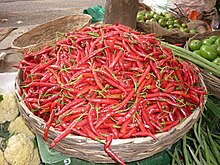
In India, most households always keep a stock of fresh hot green chilies at hand, and use them to flavor most curries and dry dishes.
Chili is a staple fruit in Bhutan. Bhutanese call this crop ema (in Dzongkha) or solo (in Sharchop). The ema datshi recipe is entirely made of chili mixed with local cheese.
Chilies are present in many cuisines. Some notable chili dishes include
Fresh or dried chilies are often used to make
Ornamental plants
The contrast in color and appearance makes chili plants interesting to some as a purely decorative garden plant.
Black pearl pepper - Black Hungarian pepper: green foliage, highlighted by purple veins and purple flowers, jalapeño-shaped fruits[44]
- Bishop's crown pepper, Christmas bell pepper: named for its distinct three-sided shape resembling a red bishop's crown or a red Christmas bell[45]
Psychology
Psychologist Paul Rozin suggests that eating chilies is an example of a "constrained risk" like riding a roller coaster, in which extreme sensations like pain and fear can be enjoyed because individuals know that these sensations are not actually harmful. This method lets people experience extreme feelings without any significant risk of bodily harm.[46]
Topical use and health research
Capsaicin, the pungent chemical in chili peppers, is used as an analgesic in topical ointments, nasal sprays, and dermal patches to relieve pain.[47] A 2022 review of preliminary research indicated that regular consumption of chili peppers was associated with weak evidence for a lower risk of death from cardiovascular diseases and cancer.[48]
Chemical irritants
Capsaicin extracted from chilies is used in
Crop defense
Food defense
Birds do not have the same sensitivity to capsaicin, because it targets a specific
Nutritional value
| Nutritional value per 100 g (3.5 oz) | |
|---|---|
| Energy | 166 kJ (40 kcal) |
8.8 g | |
| Sugars | 5.3 g |
| Dietary fiber | 1.5 g |
0.4 g | |
1.9 g | |
beta-Carotene | 5% 48 μg5% 534 μg |
| Vitamin B6 | 30% 0.51 mg |
| Vitamin C | 160% 144 mg |
| Minerals | Quantity %DV† |
| Iron | 6% 1 mg |
| Magnesium | 5% 23 mg |
| Potassium | 11% 322 mg |
| Other constituents | Quantity |
| Water | 88 g |
| Capsaicin | 0.01g – 6 g |
| †Percentages estimated using US recommendations for adults,[52] except for potassium, which is estimated based on expert recommendation from the National Academies.[53] | |
Red hot chili peppers are 88% water, 9%
Spelling and usage
The three primary spellings are chili, chile and chilli, all of which are recognized by dictionaries.
- Chili is widely used in English of the United States[54] and optionally in Canada.[55] However, it is also commonly used as a short name for chili con carne (literally "chili with meat"),[54] most versions of which are seasoned with chili powder, which in turn can refer to pure dried, ground chili peppers, or to a mixture containing other spices.
- Chile is the most common Spanish spelling in Mexico and several other Latin American countries,[56] as well as some parts of the United States[57] which refers specifically to this plant and its fruit. In the Southwest United States (particularly New Mexico), chile also denotes a thick, spicy, un-vinegared sauce made from this fruit, available in red and green varieties, and served over the local food, while chili denotes the meat dish. The plural is chile or chiles.
- Chilli was the original Romanization of the Náhuatl language word for the fruit (chilli)[58] and is the preferred British spelling according to the Oxford English Dictionary, although it also lists chile and chili as variants.[58] Chilli (and its plural chillies) is the most common spelling in India,[59] Sri Lanka,[60] Australia, Malaysia, New Zealand, Pakistan, Singapore, South Africa, and variably in Canada.
The name of the plant is unrelated to that of
Though pepper originally referred to the genus
Safety
The
Gallery
-
Illustration from the Japanese agricultural encyclopedia Seikei Zusetsu (1804)
-
The habanero pepper
-
Buds and flowers
-
Immature chilies in the field
-
Ripe chilies in the field, Myanmar
-
The Black Pearl cultivar
-
Cubanelle peppers
-
Ripe chili pepper with seeds
-
Scotch bonnet chili peppers in a Caribbean market
-
Chili peppers drying in Kathmandu, Nepal
-
Removing seeds and pith from dried chilies in San Pedro Atocpan, Mexico
-
Dried chili pepper flakes and fresh chilies
-
Chili pepper dip in a traditional restaurant in Amman, Jordan
-
Dried Thai bird's eye chilies
-
Green chilies
-
Guntur chilli drying in the sun, Andhra Pradesh, India
-
Sundried chili at Imogiri, Yogyakarta, Indonesia
-
New Mexico chiles dried on the plant in Mesilla, New Mexico
-
Chili pepper wine from Virginia
-
White flower of chili paper at night
-
Pickled chili in India
-
Chili peppers cultivated in Myanmar
-
Dried chili pepper flakes, Myanmar
-
Green Chillies from North India. They are used as spice in many Indian dishes.
See also
- Chili grenade, a type of weapon made with chili peppers
- Food and drink prohibitions, which in some cultures includes chili peppers
- Hatch, New Mexico, known as the "Chile Capital of the World"
- History of chocolate, which the Maya drank with ground chili peppers
- International Connoisseurs of Green and Red Chile, organization for the promotion of chili peppers
- Peppersoup
- Ristra, an arrangement of dried chili pepper pods
- Salsa (sauce)
- Sweet chili sauce, a condiment for adding a sweet, mild heat taste to food
References
- ^ "Chili pepper". Germplasm Resources Information Network. Agricultural Research Service, United States Department of Agriculture.
- ^ "Capsicum annuum L." theplantlist.org. The Plant List.
- ^ Dasgupta, R. R. (8 May 2011). "Indian chilli displacing jalapenos in global cuisine". The Economic Times.
- ^ "HORT410. Peppers – Notes". Purdue University Department of Horticulture and Landscape Architecture. Archived from the original on 26 December 2018. Retrieved 20 October 2009.
Common name: pepper. Latin name: Capsicum annuum L. ... Harvested organ: fruit. Fruit varies substantially in shape, pericarp thickness, color and pungency.
- ^ peppergeek (28 September 2022). "Paprika vs. Chili Powder vs. Cayenne: What's The Difference?". Pepper Geek. Retrieved 19 September 2023.
- ^ Mishan, Ligaya (18 August 2022). "How The Chili Became Hot". The New York Times. Retrieved 1 October 2022.
- ^ S2CID 205772121.
- ^ S2CID 36556206. Retrieved 11 February 2022.
- ^ PMID 24753581.
- ^ "Green chili production in 2019; Crops/World Regions/Production Quantity/Green Chillies and Peppers from pick lists". UN Food and Agriculture Organization, Statistics Division (FAOSTAT). 2021. Retrieved 12 December 2021.
- ^ a b c Bosland PW (1998). "Capsicums: Innovative uses of an ancient crop". In Janick J (ed.). Progress in New Crops. Arlington, VA: ASHS Press. pp. 479–487. Retrieved 23 December 2010.
- ^ "Birthplace of the domesticated chili pepper identified in Mexico". EurekaAlert, American Association for the Advancement of Science. 21 April 2014.
- PMID 27245634.
- ^ PMID 26402618.
- ISBN 9780851993355. Retrieved 29 November 2018.
- ^ ISBN 9781351440622.
- ^ ISBN 9781420004366.
- ^ Wallin, Nils-Bertil (11 June 2004). "Chili: Small Fruit Sets Global Palettes on Fire". YaleGlobal Online. Yale University. Retrieved 5 January 2024.
- ISBN 9780826361806.
- ISBN 978-0-09-943786-4.
- ISBN 978-81-89422-44-8.
- ^ a b "Green chili production in 2020; Crops/World Regions/Production Quantity/Green Chillies and Peppers from pick lists". UN Food and Agriculture Organization, Statistics Division (FAOSTAT). 2022. Retrieved 17 May 2022.
- ISBN 9781461437758. Retrieved 28 November 2018.
- . Chem. Abstr. 1964, 60, 9827g.
- ^ Kosuge S, Inagaki Y (1962). "Studies on the pungent principles of red pepper. Part XI. Determination and contents of the two pungent". J. Agric. Chem. Soc. Japan (in Japanese). 36: 251–254.
- ISSN 0018-5345.
- PMID 23023032.
- ^ "History of the Scoville Scale | FAQS". Tabasco.Com. Archived from the original on 23 August 2010. Retrieved 23 December 2010.
- ^ PMID 18695236.
- ^ Filippone PT (11 October 2000). "Chile Pepper Heat Scoville Scale". Homecooking.about.com. Archived from the original on 26 February 2012. Retrieved 14 April 2013.
- ^ Atwal S (16 October 2023). "Pepper X dethrones Carolina Reaper as world's hottest chilli pepper". Guinness World Records. Retrieved 16 October 2023.
- ^ Morris L (22 January 2018). "The Hottest Chilli in the World was Created in Wales Accidentally". National Geographic. Archived from the original on 18 February 2018. Retrieved 17 February 2018.
- ^ Lynch K (19 November 2013). "Confirmed: Smokin Ed's Carolina Reaper sets new record for hottest chilli". Guinness World Records. Retrieved 8 November 2014.
- ^ Bryan SM (16 February 2012). "Trinidad Moruga Scorpion wins hottest pepper title". Yahoo! News. Associated Press. Archived from the original on 1 April 2012. Retrieved 11 May 2013.
- ^ Joshi M (11 March 2012). "Chile Pepper Institute studies what's hot". Your life. USA Today. Archived from the original on 14 March 2012.
- ^ Da Silva M (12 April 2011). "Aussies grow world's hottest chilli". Australian Geographic. Archived from the original on 28 October 2011. Retrieved 12 April 2011.
- ^ "Title of world's hottest chili pepper stolen – again". The Independent. London. 25 February 2011. Retrieved 27 February 2011.
- ^ Henderson N (19 February 2011). ""Record-breaking" chilli is hot news". BBC News. Retrieved 20 February 2011.
- ^ "Home". Guinness World Records.
- ^ Robinson S (14 June 2007). "Chili Peppers: Global Warming". Time. Retrieved 25 May 2019.
- ^ McQuaid J (20 February 2015). "What's driving the global chili pepper craze?". Forbes Media. Retrieved 25 May 2019.
- ^ "Dahon ng Sili (Chili pepper leaves)". Tribo ความสุขบนเตียง. Archived from the original on 12 March 2007.
- ^ "Vitamin Rich Chili pepper Leaf Kimchi". Ssoft International Corporation. Archived from the original on 14 November 2009.
- ^ "Chilies as Ornamental Plants". Seedsbydesign. Archived from the original on 15 May 2013.
- ^ "Bishop's crown pepper, image". CayenneDiane.com.
- S2CID 143848453.
- PMID 27367653.
- PMID 34977833.
- ^ PMID 29052530.
- ^ Mott M. "Elephant Crop Raids Foiled by Chili Peppers, Africa Project Finds". National Geographic. Archived from the original on 29 October 2013. Retrieved 23 October 2013.
- S2CID 4389051.
- ^ United States Food and Drug Administration (2024). "Daily Value on the Nutrition and Supplement Facts Labels". Retrieved 28 March 2024.
- )
- ^ a b "Chili". Merriam-Webster.com Dictionary. Retrieved 21 July 2021.; other spellings are listed as variants, with "chilli" described as "chiefly British"
- ^ The Canadian Oxford Dictionary lists chili as the main entry, and labels chile as a variant, and chilli as a British variant.
- ISBN 978-0-674-79681-2.
- ^ "chile". Merriam-Webster.com Dictionary. Retrieved 21 July 2021.
- ^ OED. Vol. 2 C (1 Corrected re-issue ed.). Oxford, UK. 1933. p. 346. Retrieved 19 July 2021.)
{{cite encyclopedia}}: CS1 maint: location missing publisher (link - ^ Usage example: "Fall in exports crushes chilli prices in Guntur". Thehindubusinessline.com. Retrieved 21 April 2012.
- ^ Usage example: "Chilli, Capsicum and Pepper are spicy plants grown for the pod. Green chilli is a culinary requirement in any Sri Lankan household". The Sunday Times. Retrieved 21 April 2012.
- ^ OED. Vol. 7 N–Poy (1 Corrected re-issue ed.). Oxford, UK. 1913. p. 663. Retrieved 19 July 2021.) (sense 2b of pepper)
{{cite encyclopedia}}: CS1 maint: location missing publisher (link - ^ "pepper". Merriam-Webster.com Dictionary. Retrieved 21 July 2021.
- ^ Andrea Beck (8 May 2019). "How to Handle Hot Peppers and Chiles Safely". Better Homes and Gardens. Retrieved 23 July 2022.
Further reading
- Kottasová I, Hunt K (4 October 2021). "How chili peppers helped Nobel Prize winners understand how we feel heat". CNN.
- Murez C (9 November 2020). "Hot Discovery: Chili Peppers Might Extend Your Life". U.S. News & World Report. Retrieved 4 October 2021.
- "Researchers develop portable device to quantify capsaicin content in chili peppers". News Medical Life Sciences. 22 October 2020. Retrieved 4 October 2021.
External links
- Plant Cultures: Chilli pepper botany, history and uses
- The Chile Pepper Institute of New Mexico State University
- Capsicums: Innovative Uses of an Ancient Crop
- Chilli: La especia del Nuevo Mundo (Article from Germán Octavio López Riquelme about biology, nutrition, culture and medical topics. In Spanish)
- The Hot Pepper List List of chili pepper varieties ordered by heat rating in Scoville Heat Units (SHU)


